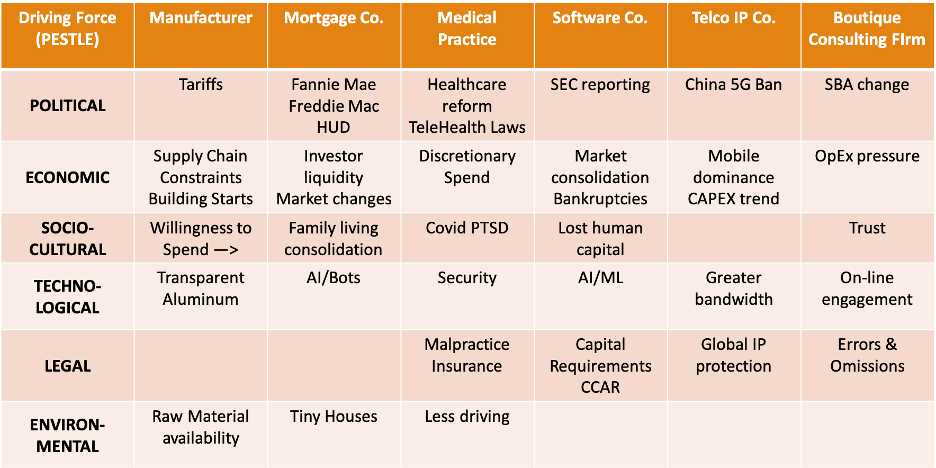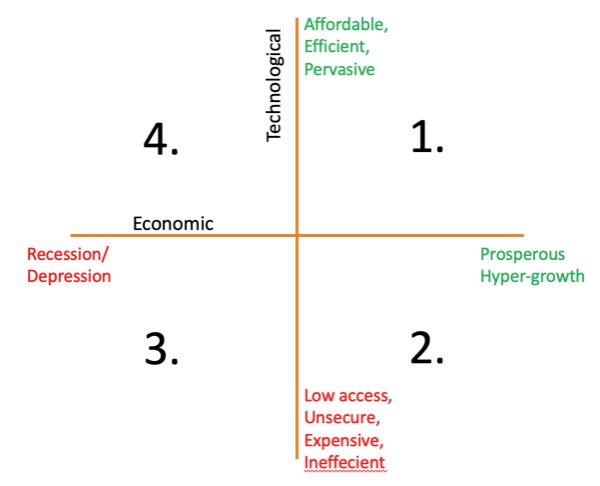Making scenario modeling and planning a new core competency
By Ron Dimon, Connected Planning Advisor, MRWD LLC. July 2020
In our drive to wring every dollar of profit from our organizations, we have adopted one or more of the following business practices over time:
- Moved to Just-in-time inventory
- Sourced the lowest-cost material providers
- Added many part-time and contract workers in lieu of full-time employees
- Outsourced our customer support organizations
- Taken slack out of our systems & processes
- Stock buybacks instead of innovation investments
- Dropped our prices ‘just to win the business’
- Managed the business and made investment decisions for quarterly earnings goals, not for the long-term success of our people, customers, products, and markets.
And then the pandemic happened. We were all caught unprepared. We moved into survival mode: liquidity and cashflow, product pivot, re-pricing, and layoffs. Like most of my clients, I hate being unprepared and I hate surprises. Hopefully, bringing your attention to the practice of scenario planning, and a scenario-thinking mindset, will encourage you to build-out scenario modeling and planning as a core-competency in your organization.
What can we do differently?
How does planning happen in your organization? If you’re like most, it’s largely an annual or quarterly process centered around sales, headcount, and capex. Operational planning like demand, capacity, inventory (S&OP – Sales & Operations Planning) or sales territory & quota can be more rigorous but is usually disconnected from workforce, marketing, R&D, and all kinds of other planning. The first question to ask is “are we getting material value from planning that’s commensurate with the total level of effort and expense we put into it?” Or even better: “How is planning & modeling having a direct impact on material growth and profitability?” Next, take a look at scenario modeling. Again, if you’re like most organizations, this is done by a few people, based on opportunities like mergers, acquisitions, divestitures, product rationalization, or pricing exercises and in a series of spreadsheets – driven by an executive or board request.
How do we turn these administrative ‘chores’ into a core-competency that helps you be more agile, more competitive, and, yes, more ready for surprises, black swans, and black elephants[1]?
The first step is to understand where the Coronavirus pandemic caught you short. Identify where you were underprepared, where your blind-spots were, and in what areas you took the longest to find out the impact on 2020. You can’t fix the past, but you can learn from it. If you haven’t already convened a response task force, or if you have and it’s done the basic blocking & tackling of liquidity and cashflow, turn this team into a planning center of excellence. Its remit is to identify all those areas that you cut, skimmed, squeezed, and ignored, and then to build a vision of new levels of transparency, accountability, and scenario-thinking culture. I also think that having a ‘coming from the future’ (rather than fixing the past) mindset is key to transforming planning & modeling in your organization[2].
How do we go about doing it?
There is no perfect, one-size-fits-all methodology for scenario-thinking and scenario planning. But there are a variety of ingredients you can put together to make one that is perfect for you. A great place to start is with the PESTLE[3] method. This is an acronym for Political, Economic, Social, Technological, Environmental, and Legal forces that can impact your planning and performance.
We usually spend our time planning & analyzing internal factors that we have more control over, rather than PESTLE factors that we generally can’t control. Getting better at getting ready means we now must consider all these external forces as we build models of future scenarios. It’s useful to think about performance drivers and our ability to control them, for example:
| Direct control | Situational control | Low or no control |
| Strategic objectives | Channels | Markets |
| Employees & Locations | Vendors/suppliers | Competition |
| Products | Customers | Political situation |
| Innovation | Sentiment/Brand | Economic issues |
| Pricing | Technology | Legal |
| Communications | Socio-cultural issues | Environmental |
In considering these forces, we can design and build scenario models that include our assumptions about them, what value drivers they can impact, data (internal & external) showing past performance and even predictive or consensus expectations.
Here’s a quick look at PESTLE forces by type of business, and potential concerns for each. Note that not all forces are a concern for all industries:

That’s a lot of forces, and for a scenario to be debate-worthy and useful, we can deal with 2 of those forces at a time. We start with a 2×2 matrix of intersections of possible circumstances or outcomes and their impact on our organization.
For example, in a workshop for a medical practice group, we chose Technological and Economic as our two PESTLE forces. We drew the 2×2 with the extremes at each end of the spectrum:

At each of the 4 intersections, we have a debate about a possible future scenario and their impact on our customers, workforce, supply chain, and so on. We think about those drivers that are both material (having a greater impact on our performance) and volatile (needing more monitoring and analysis since change happens quickly).
Very quickly, obvious actions emerge to help prepare and protect our ecosystem from those particular scenarios. It turns out that it’s not really about the scenario you imagine or the model you build, it’s about the debate you have in building the model (what’s important, what are our objectives & values, what assumptions need challenging).
What’s the next step?
Organization that want to build scenario-planning and modeling as a core-competency can get started with a low cost to entry. A simple path includes:
-
- Start a scenario planning team, deliver scenario thinking training
- Involve as many points of view as you can: executives, managers, front-line customer-facing employees, partners/vendors, suppliers, customers
- Expose your assumptions, capture your constraints
- Data, data, data – use a platform that can capture your models and scenarios and is driven off of existing internal (P&L, Balance Sheet, Cashflow, Customer, etc.) as well as external (competitive, pricing, demographic) data.
- Make scenario planning a core-capability, a repeatable process, and tie to performance (ie variable comp, measures of success) – score yourself on it regularly
Recovery is what we are up to right now. Resilience is where we want to get to. Spending more time and resources on preparing for multiple eventualities is the key to reducing surprises.
Ron Dimon is an independent consultant focused on scenario thinking and what-if modeling. For over 30 years, Ron has been designing and building Finance and Enterprise Performance Management (EPM) technologies and processes. He helps large organizations design strategic, financial and operational planning & forecasting solution roadmaps and business processes & practices. At Deloitte, Ron was the Anaplan Global Alliance Partner where he helped build a global Connected Planning practice. Ron is the author of Enterprise Performance Management Done Right, An Operating System for Your Organization (John Wiley & Sons, 2013). Originally from Toronto, Canada, he lives in Santa Fe, NM.
[1] A black elephant is a cross between a “black swan” — an unlikely, unexpected event with enormous ramifications — and the “elephant in the room” — a looming disaster that is visible to everyone, yet no one wants to address. Read “How We Broke The World” by Thomas L. Friedman, New York Times, Sunday May 31, 2020
[2] Refer to Vanto Group’s “A Future to Go Back to: Planning in Times of Uncertainty”
[3] For a good overview, see https://www.business-to-you.com/scanning-the-environment-pestel-analysis/